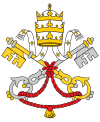Rite of Braga
The Rite of Braga is a liturgical rite associated with the Archdiocese of Braga in Portugal.
The Rite of Braga belongs to the Roman family of liturgical rites and took shape within the Archdiocese of Braga between the 11th and 13th centuries.[1] Being more than 200 years old at the time of Pope Pius V's papal bulls Quod a nobis of 9 July 1568 and Quo primum of 14 July 1570, the Rite of Braga was unaffected by the imposition of the Roman Rite throughout the Latin Church except where another rite of an antiquity of at least two centuries existed. However, the Roman Rite was increasingly adopted within the archdiocese and non-traditional elements were admitted into celebrations of the archdiocese's own rite.[1]
In the 20th century an attempt was made by Archbishop Manuel Vieira de Matos with the approval of Pope Pius XI to expunge these accretions, to revise the texts and to make the rite obligatory within the archdiocese.[2][3] However, after the Second Vatican the priests of the archdiocese, although they are authorized to use the Rite of Braga, have in general opted in practice to use the Roman Rite.[4]
A particularity of the Rite of Braga is the recitation of the Ave Maria at the start of Mass and of the Sub tuum praesidium at the end.[5]
The Rite of Braga was one of the liturgical rites whose variety within the one Latin Church Cardinal Joseph Ratzinger mentioned in a talk he gave on 24 October 1998 as showing that unity does not require liturgical uniformity.[6]
References
- 1 2 Alcuin Reid, The Organic Development of the Liturgy (Liturgical Press 2005 ISBN 9781586171063), p. 128
- ↑ Reid (2005), p. 129
- ↑ Matthew Bunson, Timothy M. Dolan, OSV's Encyclopedia of Catholic History (Our Sunday Visitor Publishing 2004 ISBN 9781592760268), p. 160
- ↑ Filipe d’Avillez, "The Rite of Braga Celebrated Yesterday in Fatima"
- ↑ Michael A. Mullett, The Catholic Reformation (Routledge 1999 ISBN 9780415189156), p. 184
- ↑ "Cardinal Ratzinger on the old and the new Mass"
| |||||||||||||||||||||||||||||
